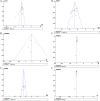Psychological interventions for post-traumatic stress injuries among public safety personnel: a systematic review and meta-analysis
- PMID: 36434683
- PMCID: PMC9701019
- DOI: 10.1186/s13643-022-02112-1
Psychological interventions for post-traumatic stress injuries among public safety personnel: a systematic review and meta-analysis
Abstract
Background: Public safety personnel (PSP) are exposed to potentially psychologically traumatic events (PPTE) far more often than the general public, which increases the risk for various post-traumatic stress injuries (PTSIs). While there are many evidence-based psychological interventions for PTSI, the effectiveness of each intervention for PSP remains unclear.
Objectives: The current study assessed the effectiveness and acceptability of psychological interventions for PTSI among PSPs.
Methods: A systematic review and random-effects meta-analysis were performed on the effectiveness and acceptability of psychotherapies for PTSIs (i.e., symptoms of depression, anxiety, post-traumatic stress disorder) among PSP. The review adhered to the PRISMA reporting guidelines and used standardized mean differences (Cohen's d), rate ratios (RR), and their 95% confidence intervals (95% CI) to measure pooled effect sizes across studies; negative d values and RR values less than one indicated a reduction in symptoms compared to baseline or control groups. In addition, heterogeneity was quantified using I2, and publication bias was evaluated using Egger's test.
Results: The analyses included data from eight randomized controlled trials representing 402 PSP (79.4% male, 35.3 years). Psychological interventions included narrative exposure therapy (n = 1), cognitive behavioral therapy (n = 2), eclectic psychotherapy (n = 2), eye-movement desensitization and reprocessing (n = 1), supportive counseling (n = 2), and group critical incident stress debriefing (n = 1). The interventions were associated with statistically significant reductions in symptoms associated with PTSD (d = - 1.23; 95% CI - 1.81, - 0.65; 7 studies; I2 = 81%), anxiety (- 0.76; 95% CI - 1.28, - 0.24; 3 studies; I2 = 47%), and depression (d = - 1.10; 95% CI - 1.62, - 0.58; 5 studies; I2 = 64%). There were smaller but statistically significant improvements at follow-up for symptoms of PTSD (d = - 1.29 [- 2.31, - 0.27]), anxiety (d = - 0.82 [- 1.20, - 0.44]), and depression (d = - 0.46 [- 0.77, - 0.14]). There were no statistically significant differences in dropout rates (RR = 1.00 [0.96, 1.05]), suggesting high acceptability across interventions.
Conclusions: There is preliminary evidence that psychotherapies help treat PTSIs in PSP; however, the shortage of high-quality studies on PSP indicates a need for additional research into treating PTSI among PSP.
Systematic review registration: PROSPERO: CRD42019133534.
© 2022. The Author(s).
Conflict of interest statement
Dr. Bahji is a recipient of the 2020 Friends of Matt Newell Endowment in Substance Abuse through the University of Calgary Cumming School of Medicine.
Figures






References
-
- Kennedy SH, Lam RW, McIntyre RS, Tourjman SV, Bhat V, Blier P, et al. Canadian Network for Mood and Anxiety Treatments (CANMAT) 2016 clinical guidelines for the management of adults with major depressive disorder. Can J Psychiatry Rev Can Psychiatr. 2016;61:540–560. doi: 10.1177/0706743716659417. - DOI - PMC - PubMed
-
- Pietrzak RH, Goldstein RB, Southwick SM, Grant BF. Prevalence and Axis I comorbidity of full and partial posttraumatic stress disorder in the United States: results from Wave 2 of the National Epidemiologic Survey on Alcohol and Related Conditions. J Anxiety Disord. 2011;25:456–465. doi: 10.1016/j.janxdis.2010.11.010. - DOI - PMC - PubMed
Publication types
MeSH terms
LinkOut - more resources
Full Text Sources
Medical
Miscellaneous

